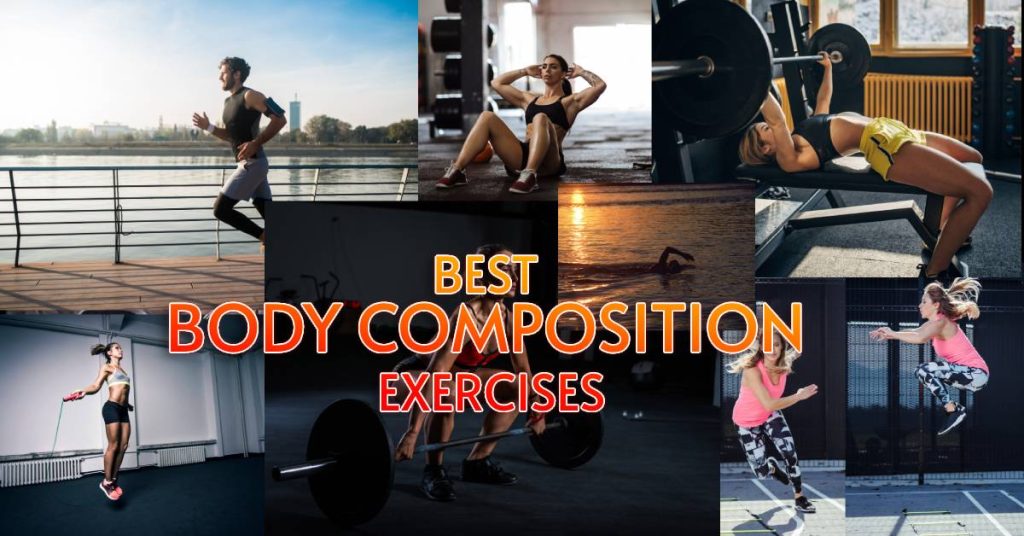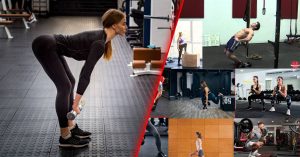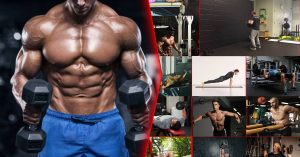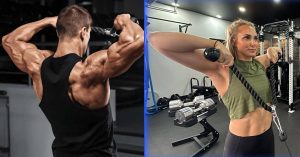You may be wondering over the internet to find out what are the best Body Composition Exercises that can help you to enhance your body fitness. It is a true fact that not all workouts shape your physique in the same way you dream to gain.
If you are looking to tone up and get in shape, It’s all about finding the right exercises to help you build muscle and burn fat. For that, you need to understand your body composition well. Here, body composition, we meant to ask the ratio of how much muscle versus fat you have.
In this article, we’ll break down the best exercises to help you improve your body composition. Whether you’re aiming to pack on muscle or slim down, these workouts are tailored to help you get there. Say goodbye to guesswork and hello to a fitter, more defined you!
Let’s dive in and discover the exercises that will get you the results you want. Get ready to transform your body and achieve your ideal physique.
Table of contents
MORE keyboard_double_arrow_down LESS keyboard_double_arrow_up
What Is Body Composition?
Body composition refers to the makeup of the human body in terms of its various components, including fat mass, lean body mass (muscle, bone, organs, and tissues), water, and minerals.
It is a detailed analysis of what the body is composed of beyond just overall body weight. This analysis provides insights into the distribution of these components throughout the body. It is often expressed as a percentage of total body weight.
- For men, a healthy body fat percentage typically falls between 18-24%,
- For women, the healthy body fat percentage ranges from 25-31%.
However, these ranges can vary depending on factors such as age, muscle mass, physical activity level, and underlying health conditions (source). For instance, athletes often exhibit lower body fat percentages due to higher muscle mass.
Additionally, body composition analysis is commonly used in fitness, and sports performance. Plus, it is used in medical settings to assess progress, set goals, and develop personalized strategies for achieving optimal body composition and overall well-being.
What is meant by healthy body composition and Poor body composition?
- A healthy body composition typically includes a balanced ratio of lean body mass to fat mass, with an emphasis on maintaining adequate muscle mass while minimizing excess body fat.
- Poor body composition, characterized by excessive fat mass or inadequate lean mass, is associated with an increased risk of various health problems. These diseases can include,
- Obesity,
- Cardiovascular disease,
- Metabolic disorders,
- Musculoskeletal issues.
By determining your target body fat percentage, you can effectively customize your diet, exercise, and lifestyle habits. These customizations will surely help you optimize your health, improve physical performance, and reduce the risk of chronic diseases.
How Can I Measure My Body Fat Percentage?
There are several methods you can use to measure your body fat percentage, each with its own advantages and limitations.
Here are some common methods:
- Skinfold Calipers: This method involves using calipers to measure the thickness of skinfolds at various sites on the body. These measurements are then used to estimate body fat percentage using equations. Skinfold calipers are relatively inexpensive and can be used at home, but accuracy depends on the skill of the person taking the measurements.[source]
- Bioelectrical Impedance Analysis (BIA): BIA devices send a low-level electrical current through the body and measure how it travels through different tissues. This information is used to estimate body fat percentage. BIA scales are convenient and widely available, but factors such as hydration levels can affect accuracy.[Source]
- Dual-Energy X-ray Absorptiometry (DEXA): DEXA scans use X-rays to differentiate between bone, fat, and lean tissue. They provide highly accurate measurements of body composition but require specialized equipment and can be expensive.[Source]
- Hydrostatic Weighing: Hydrostatic weighing involves submerging the body in water to measure its volume. Body density is then calculated from the underwater weight and used to estimate body fat percentage. This method is highly accurate but requires access to specialized facilities.
- Air Displacement Plethysmography (Bod Pod): Similar to hydrostatic weighing, the Bod Pod measures body volume by determining the amount of air displaced when a person sits inside a sealed chamber. It provides accurate results but may not be widely available.[Source]
- 3D Body Scanners: These scanners create a 3D image of the body, which can be used to estimate body fat percentage. They are non-invasive and provide a comprehensive analysis of body composition, but availability may be limited.
You need to consider factors such as cost, accessibility, and desired level of accuracy when choosing a method to measure body fat percentage. It’s also important to follow instructions carefully and take measurements under consistent conditions for the most reliable results.
Additionally, consulting with a healthcare professional or fitness expert can help you select the best method for your needs.
Why Body Composition Matters?
Body composition refers to the proportion of fat, muscle, bone, and water in the body. It is a crucial indicator of overall health and fitness because it offers insights beyond just body weight.
Here are some reasons that show why body composition matters:
- Health Assessment: Body composition provides a more accurate assessment of health status than body weight alone. Excessive body fat, especially visceral fat (fat stored around internal organs), is associated with an increased risk of chronic diseases such as heart disease, type 2 diabetes, and certain cancers.
- Conversely, having a healthy amount of lean muscle mass is linked to improved metabolic health and better disease prevention.
- Performance Enhancement: Whether you’re an athlete, fitness enthusiast, or simply someone aiming to improve physical performance, optimizing body composition can enhance athletic abilities. A balanced ratio of muscle to fat promotes strength, power, endurance, agility, and flexibility, contributing to better athletic performance across various sports and activities.
- Functional Fitness: Maintaining an optimal body composition is essential for everyday functional movements and activities. Having a strong muscular framework supports proper posture, balance, and mobility, reducing the risk of injuries and enhancing daily tasks like lifting objects, climbing stairs, and bending over.
- Metabolic Efficiency: Body composition significantly influences metabolic rate—the rate at which your body burns calories. Muscle tissue is metabolically active, meaning it burns more calories at rest compared to fat tissue. Therefore, individuals with a higher proportion of muscle mass tend to have a higher basal metabolic rate (BMR), which can aid in weight management and weight loss efforts.
- Psychological Well-being: Achieving a healthy body composition can positively impact mental health and self-esteem. Excess body fat and poor body composition are often associated with body image dissatisfaction and psychological distress. Conversely, improving body composition through regular exercise and proper nutrition can boost self-confidence, mood, and overall well-being.
Body composition matters because it provides valuable insights into overall health, influences physical performance and functional abilities, affects metabolic efficiency, and plays a significant role in psychological well-being.
You can work towards achieving better health outcomes and improved quality of life by understanding and actively managing body composition through appropriate exercise, nutrition, and lifestyle choices.
What Are The Top 14 Body Composition Exercises?
Achieving an optimal body composition requires a balanced approach that combines cardiovascular exercise with strength and resistance training.
Here’s a comprehensive list of the top 14 exercises that target various muscle groups and contribute to improved body composition:
Cardiovascular Exercise:
Cardiovascular exercise, often known as cardio, is essential for improving heart health, boosting fitness levels, and promoting overall well-being. These activities elevate your heart rate and enhance circulation, offering a myriad of benefits such as improved endurance, calorie burning, and reduced risk of chronic diseases.
In this section, let us find out what are the top cardiovascular exercises and how to practice them in order to gain optimal health outcomes.
1. Running/Jogging

Running or jogging is a popular cardiovascular exercise that can be performed indoors on a treadmill or outdoors on various terrains. It is an excellent way to elevate heart rate, burn calories, and improve overall cardiovascular health.
How To Do Running/Jogging?
To perform running or jogging,
- Start by warming up with light stretching or brisk walking.
- Then, maintain a steady pace, keeping your posture upright and arms relaxed.
- Focus on breathing rhythmically and landing softly on the midfoot.
- Gradually increase speed or incline as your fitness improves.
Execution Tips Enhanced:
- Wear proper footwear with good cushioning and support to minimize the risk of injury.
- Choose appropriate terrain, whether it’s a treadmill, track, or outdoor trails.
- Land softly on the midfoot and roll through to the toes with each step to reduce the impact on joints.
- Focus on breathing rhythmically, inhaling through the nose and exhaling through the mouth.
- Stay hydrated and maintain proper nutrition to support your running performance.
Why It Works Explained:
Running or jogging engages large muscle groups such as the quadriceps, hamstrings, calves, and glutes, resulting in increased calorie expenditure and improved cardiovascular endurance. The repetitive motion of running also strengthens bones and connective tissues, contributing to overall musculoskeletal health
2. Cycling

Cycling, whether on a stationary bike or outdoors, offers a low-impact yet effective cardiovascular workout. It targets the lower body muscles while providing an enjoyable and accessible form of exercise.
How To Do Cycling?
- Start by adjusting the seat height to ensure proper leg extension at the bottom of the pedal stroke.
- Begin pedaling at a comfortable pace, gradually increasing resistance or speed as desired.
- Maintain a steady cadence, keeping your upper body relaxed and your core engaged.
- Focus on smooth pedal strokes, pushing down and pulling up with equal effort.
Execution Tips Enhanced:
- Use proper bike fit to prevent strain on your joints and ensure efficient pedaling mechanics.
- Maintain a relaxed grip on the handlebars and keep your upper body relaxed to reduce tension in the shoulders and neck.
- Pay attention to posture and hand positioning to reduce fatigue and maintain comfort during longer rides.
- Incorporate interval training by alternating between periods of higher intensity and recovery to maximize calorie burn and cardiovascular benefits.
Why It Works Explained:
Cycling primarily targets the quadriceps, hamstrings, and glutes while also engaging the calves and hip flexors. The rhythmic motion of pedaling improves cardiovascular endurance and efficiency. At the same time, the low-impact nature of cycling minimizes stress on the joints, making it suitable for individuals of all fitness levels.
3. Swimming

Swimming is a full-body exercise that provides an excellent cardiovascular workout while being gentle on the joints. It engages multiple muscle groups simultaneously, making it an efficient way to improve overall fitness and body composition.
How To Do Swimming?
- Begin by warming up with a few laps of easy swimming, focusing on proper stroke technique and breathing rhythm.
- Experiment with different strokes, such as freestyle, breaststroke, backstroke, and butterfly, to target various muscle groups and keep the workout engaging.
Execution Tips Enhanced:
- Pay attention to breathing technique, exhaling underwater and inhaling as your face breaks the surface.
- Use proper form for each stroke, including a streamlined body position, long, fluid arm movements, and a strong kick from the hips.
- Incorporate interval training by alternating between different strokes or varying intensity to challenge the cardiovascular system and increase calorie expenditure.
Why It Works Explained:
Swimming engages the muscles of the arms, shoulders, back, core, and legs in a coordinated manner, providing a comprehensive full-body workout. The resistance of the water adds intensity to the exercise while also providing natural buoyancy that reduces impact on the joints, making it suitable for individuals with joint pain or injury.
4. Rowing

Rowing is a highly effective cardiovascular exercise that engages both the upper and lower body muscles. It simulates the action of rowing a boat and provides a full-body workout while being low-impact on the joints.
How To Do Rowing?
- Begin by sitting on the rowing machine with your feet secured in the foot straps and knees slightly bent.
- Grab the handle with an overhand grip and extend your arms forward.
- Push through your legs to straighten them, then lean back slightly and pull the handle towards your chest, engaging your back and arm muscles.
- Reverse the motion to return to the starting position.
- Repeat the next repetition.
Execution Tips Enhanced:
- Maintain a tall posture with a straight back throughout the rowing motion to maximize power and prevent strain on the lower back.
- Focus on driving through your legs during the drive phase of the rowing stroke, then smoothly transition to pulling with your arms and engaging your back muscles.
- Control the return phase of the stroke to prevent the handle from slamming forward and maintain tension on the muscles for a more effective workout.
Why It Works Explained:
Rowing targets the muscles of the legs, back, arms, shoulders, and core, providing a comprehensive full-body workout. The rhythmic, repetitive motion of rowing improves cardiovascular endurance and muscular strength while also enhancing coordination and balance.
Additionally, the resistance provided by the rowing machine can be adjusted to accommodate various fitness levels and goals.
5. Jump Rope

Jumping rope is a simple yet highly effective cardiovascular exercise that can be done virtually anywhere with minimal equipment. It elevates heart rate, improves coordination, and burns calories efficiently, making it an excellent choice for enhancing body composition.
How To Do Jump Rope?
- Hold the handles of the jump rope in each hand, ensuring that the rope is behind you.
- Swing the rope over your head and jump over it as it passes under your feet.
- Land softly on the balls of your feet with knees slightly bent and immediately jump again as the rope comes around.
- Repeat the next repetition.
Execution Tips Enhanced:
- Keep your elbows close to your sides and wrists relaxed to maintain smooth rotation of the rope.
- Jump with a slight forward lean and use your wrists to control the speed and rhythm of the rope.
- Start with a comfortable pace and gradually increase speed as you become more proficient.
Why It Works Explained:
Jumping rope engages the calves, quadriceps, hamstrings, and glutes while also activating the core muscles for stability and balance. The rapid, repetitive jumping motion elevates heart rate, improving cardiovascular fitness and endurance.
Additionally, the coordination required for jumping rope enhances neuromuscular function and agility.
6. High-Intensity Interval Training (HIIT)

High-Intensity Interval Training (HIIT) involves alternating between intense bursts of activity and rest periods, maximizing calorie burn and enhancing cardiovascular fitness.
How To Do High-Intensity Interval Training (HIIT)?
- Select exercises that elevate your heart rate, such as sprinting, jumping jacks, burpees, or mountain climbers.
- Perform each exercise at maximum intensity for a set time, typically 20-30 seconds, followed by a short rest period of 10-20 seconds.
- Repeat the cycle for several rounds, aiming to maintain high intensity throughout.
Execution Tips Enhanced:
- Focus on explosive movements and maximal effort during the high-intensity intervals to maximize calorie expenditure and cardiovascular benefits.
- Monitor your exertion level and adjust the intensity and duration of intervals based on your fitness level and goals.
- Incorporate a variety of exercises and movement patterns to target different muscle groups and prevent boredom.
Why It Works Explained:
HIIT combines aerobic and anaerobic exercise, challenging both cardiovascular and muscular systems. The intense bursts of activity elevate heart rate and metabolism, promoting calorie burn both during and after the workout.
Additionally, HIIT has been shown to improve cardiovascular endurance, insulin sensitivity, and fat metabolism. The short rest intervals allow for recovery, enabling participants to sustain high intensity throughout the workout. Incorporating HIIT into your routine can lead to significant improvements in body composition, endurance, and overall fitness.
Strength & Resistance Training:
Strength and resistance training are foundational components of a well-rounded fitness regimen. These exercises focus on building muscle strength, enhancing muscular endurance, and improving overall functional fitness. By challenging your muscles against resistance, whether it’s through weights, resistance bands, or bodyweight exercises, you can stimulate muscle growth, increase bone density, and boost metabolism.
In this section, we’ll explore top strength and resistance training exercises and how to do them in order to achieve your fitness goals.
7. Squats

Squats are a fundamental compound exercise that targets multiple muscle groups simultaneously, making them essential for building lower body strength and muscle mass.
How To Do Squats?
- Begin by standing with your feet shoulder-width apart and your toes pointed slightly outward.
- Lower your body by bending your knees and hips, keeping your chest up and back straight.
- Descend until your thighs are parallel to the ground or as low as comfortable, then push through your heels to return to the starting position.
- Repeat.
Execution Tips Enhanced:
- Keep your knees aligned with your toes throughout the movement to prevent strain on the joints.
- Engage your core muscles to stabilize your spine and maintain proper posture.
- Control the descent and ascent phases of the squat to maximize muscle activation and minimize the risk of injury.
Why It Works Explained:
Squats primarily target the quadriceps, hamstrings, and glutes while also engaging the core, lower back, and stabilizing muscles. By incorporating squats into your strength training routine, you can build functional lower body strength, improve mobility, and increase overall muscle mass, leading to improved body composition.
8. Deadlifts

Deadlifts are a compound exercise that primarily targets the posterior chain muscles, including the lower back, glutes, hamstrings, and traps, making them crucial for overall strength development.
How To Do Deadlifts?
- Start by standing with your feet hip-width apart and the barbell positioned over the middle of your feet.
- Bend at the hips and knees to grip the barbell with an overhand grip slightly wider than shoulder-width apart.
- Keep your back flat, chest up, and core engaged as you push through your heels to lift the barbell, extending your hips and knees until you are standing upright.
- Lower the barbell back to the ground with control, maintaining proper form throughout.
- Repeat
Execution Tips Enhanced:
- Focus on keeping the barbell close to your body throughout the movement to minimize stress on the lower back.
- Keep your shoulders pulled back and down to maintain a neutral spine position and prevent rounding of the upper back.
- Engage your core muscles to stabilize your torso and prevent excessive arching or rounding of the spine.
Why It Works Explained:
Deadlifts are highly effective for building overall strength and muscle mass, particularly in the posterior chain muscles. By targeting large muscle groups such as the glutes, hamstrings, and lower back, deadlifts promote functional strength, improve posture, and enhance athletic performance.
Additionally, the compound nature of the exercise stimulates the release of growth hormone and testosterone
9. Bench Press

The bench press is a classic strength exercise that primarily targets the chest, shoulders, and triceps, making it an essential movement for upper body strength and muscle growth.
How To Do Bench Press?
- Lie flat on a bench with your feet planted firmly on the ground.
- Grip the barbell with hands slightly wider than shoulder-width apart, keeping your wrists straight.
- Lower the barbell to your chest by bending your elbows.
- Then push the barbell back up to the starting position, fully extending your arms.
- Repeat
Execution Tips Enhanced:
- Keep your shoulder blades retracted and your back flat against the bench to maintain stability and support proper form.
- Lower the barbell under control, avoiding rapid descent or bouncing off the chest to prevent injury.
- Exhale as you push the barbell up and inhale as you lower it down, maintaining a consistent breathing pattern throughout the exercise.
Why It Works Explained:
The bench press primarily targets the pectoralis major muscles of the chest, along with the anterior deltoids and triceps. By incorporating bench press into your strength training routine, you can increase upper body strength, muscle hypertrophy, and overall pushing power.
Additionally, the bench press recruits stabilizing muscles throughout the shoulders, arms, and core, contributing to improved functional strength and body composition.
10. Pull-Ups/Chin-Ups

Pull-ups and chin-ups are bodyweight exercises that target the muscles of the back, biceps, and grip strength, making them excellent choices for building upper body strength and muscle definition.
How To Do Pull-Ups/Chin-Ups?
- Start by hanging from a pull-up bar with your hands slightly wider than shoulder-width apart for pull-ups or closer together with palms facing towards you for chin-ups.
- Engage your back muscles and core as you pull yourself up until your chin clears the bar.
- Lower yourself back down with control until your arms are fully extended.
- Repeat
Execution Tips Enhanced:
- Focus on initiating the movement with your back muscles rather than relying solely on your arms to pull yourself up.
- Keep your shoulders down and back to maintain proper shoulder positioning and prevent shrugging.
- Squeeze your shoulder blades together at the top of the movement to fully engage the muscles of the upper back.
Why It Works Explained:
Pull-ups and chin-ups are effective for building upper body strength and muscle mass, particularly in the muscles of the back and arms. By mastering these compound exercises, you can improve grip strength, enhance pulling strength, and develop a well-rounded upper body physique.
Additionally, the ability to lift your own body weight through pull-ups and chin-ups is a valuable indicator of overall strength-to-body weight ratio, making them valuable additions to any strength training routine.
11. Planks

Planks are a fundamental core-strengthening exercise that also engage the shoulders, arms, and glutes. They are essential for improving stability, posture, and overall core strength.
How To Do Planks?
- Start by positioning yourself face down on the floor with your forearms resting on the ground and elbows directly beneath your shoulders.
- Extend your legs straight behind you, balancing on your toes.
- Engage your core muscles to lift your body off the ground, creating a straight line from your head to your heels.
- Hold this position for the desired duration, maintaining tension in your core and avoiding sagging or lifting of the hips.
- Repeat.
Execution Tips Enhanced:
- Focus on keeping your core muscles tight throughout the exercise to maximize engagement and stability.
- Keep your neck in a neutral position, avoiding excessive tilting or straining.
- Breathe deeply and steadily throughout the exercise to maintain proper oxygenation and muscle activation.
Why It Works Explained:
Planks primarily target the muscles of the core, including the rectus abdominis, transverse abdominis, obliques, and erector spinae. By holding a static position against gravity, planks strengthen these muscles, improving overall core stability and spinal alignment.
Additionally, planks engage the muscles of the shoulders, arms, and glutes, providing a comprehensive full-body workout that supports better posture, balance, and functional movement patterns.
12. Burpees
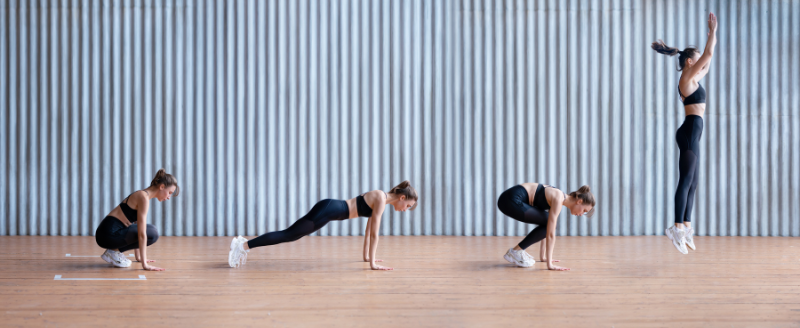
Burpees are dynamic, full-body exercises that combine elements of strength training, cardiovascular conditioning, and plyometrics. They are highly effective for burning calories, increasing heart rate, and improving overall fitness and body composition.
How To Do Burpees?
- Begin in a standing position with feet shoulder-width apart.
- Lower into a squat position, placing your hands on the ground in front of you.
- Kick your feet back into a plank position, keeping your core engaged and body in a straight line.
- Perform a push-up,
- Then quickly reverse the motion by jumping your feet back to the squat position and exploding upward into a jump, reaching your arms overhead.
Execution Tips Enhanced:
- Maintain proper form throughout the exercise, keeping your back flat and core engaged during the plank and push-up phases.
- Land softly on your feet during the jump to minimize impact on your joints and reduce the risk of injury.
- Focus on explosiveness and speed while maintaining control to maximize calorie burn and cardiovascular benefits.
Why It Works Explained:
Burpees target multiple muscle groups simultaneously, including the chest, shoulders, arms, core, quadriceps, hamstrings, and glutes. By combining strength, cardiovascular, and plyometric components, burpees elevate heart rate, increase calorie expenditure, and stimulate muscle growth and endurance.
Additionally, the high-intensity nature of burpees triggers an afterburn effect, resulting in continued calorie burn even after the exercise is complete, making them an efficient choice for improving body composition and overall fitness.
13. Sit-Ups

Sit-ups are a classic abdominal exercise that targets the muscles of the core, including the rectus abdominis and obliques. They are effective for strengthening the abdominal muscles and improving overall core stability.
How To Do Sit-Ups?
- Start by lying flat on your back with your knees bent and feet flat on the ground.
- Place your hands behind your head or across your chest.
- Engage your core muscles as you lift your upper body off the ground, curling your torso towards your thighs.
- Lower your upper body back down with control to complete one repetition.
- Repeat.
Execution Tips Enhanced:
- Keep your feet anchored firmly on the ground throughout the exercise to provide stability and support for your lower back.
- Avoid pulling on your neck or using momentum to lift your upper body, as this can strain the neck and reduce the effectiveness of the exercise.
- Focus on exhaling as you lift your torso off the ground and inhaling as you lower back down to maintain a steady breathing rhythm.
Why It Works Explained:
Sit-ups primarily target the rectus abdominis, the muscle responsible for flexing the spine and creating the “six-pack” appearance. By repeatedly contracting and lengthening the abdominal muscles, sit-ups strengthen the core and improve overall stability and posture.
Additionally, sit-ups engage the oblique muscles, which are important for rotational movements and lateral stability.
14. Lunges

Lunges are versatile lower body exercises that target the quadriceps, hamstrings, glutes, and calves while also engaging the core for stability. They are effective for building lower body strength, improving balance, and enhancing overall muscular development.
How To Do Lunges?
- Start by standing tall with your feet hip-width apart.
- Take a step forward with one foot, lowering your body until both knees are bent at a 90-degree angle, with the front thigh parallel to the ground and the back knee hovering just above the floor.
- Push through the heel of your front foot to return to the starting position,
- Then repeat on the other side.
Execution Tips Enhanced:
- Keep your torso upright and your chest lifted throughout the lunge to maintain proper posture and alignment.
- Engage your core muscles to stabilize your body and prevent excessive leaning forward or backward.
- Focus on controlling the movement and lowering yourself down with control to maximize muscle activation and reduce the risk of injury.
Why It Works Explained:
Lunges target multiple muscle groups in the lower body, including the quadriceps, hamstrings, glutes, and calves. By working these large muscle groups simultaneously, lunges help improve lower body strength, muscle endurance, and overall stability.
Additionally, lunges promote better balance and coordination, as they require unilateral movement and proprioceptive awareness.
Simple Lifestyle Changes To Achieve Your Ideal Body Composition
Achieving your ideal body composition requires a holistic approach that encompasses not only physical activity but also nutrition, sleep, and stress management. By incorporating simple lifestyle changes into your daily routine, you can optimize your efforts towards achieving your fitness goals and maintaining a healthy body composition.
1. Nutrition: Fuel for the Journey

Eating well is essential for achieving your fitness goals. In this section, we’ll explore some simple changes you can make to your diet to support your body composition goals.
- Focus on consuming a balanced diet with lean proteins, whole grains, fruits, and vegetables.
- Aim for about 1 gram of protein per pound of body weight to preserve muscle mass while reducing body fat.
- Incorporate protein-rich foods into each meal and snack to support muscle repair and growth.
- Prioritize nutrient-dense foods such as fruits and green leafy vegetables for essential vitamins and minerals.
- Stay hydrated by drinking plenty of water throughout the day.
2. Sleep: The Unsung Hero of Recovery

Quality sleep plays a crucial role in your overall health and well-being. Let’s delve into some easy adjustments you can make to your bedtime routine to improve your sleep quality and support your fitness journey.
- Aim for 7-9 hours of uninterrupted sleep each night to support recovery and hormone regulation.
- Create a conducive sleep environment by minimizing exposure to screens before bedtime and establishing a consistent sleep schedule.
- Prioritize quality sleep to enhance muscle repair, metabolism regulation, and appetite control.
- You can enhance your overall well-being and support your fitness goals by prioritizing quality sleep.
3. Stress Management: Keeping Balance

Stress can impact your body composition more than you might think. Chronic stress can lead to elevated cortisol levels, which may contribute to increased fat storage and muscle breakdown.
Here are some straightforward techniques you can use to manage stress in your daily life in order to maintain a healthy balance.
- Practice stress-reducing activities such as meditation, deep breathing exercises, or yoga to promote relaxation.
- Incorporate self-care activities into your routine to unwind and recharge.
- Manage stress effectively to reduce cortisol levels and support a healthy body composition.
- Prioritize mental well-being by taking time to relax and rejuvenate amidst daily responsibilities.
4. Physical Activity: Move Every Day

Staying active doesn’t have to mean hitting the gym for hours every day. Here are some tips that you can follow to include daily movements into your routine that can make a big difference in achieving your ideal body composition.
- Aim to be physically active every day through structured exercise sessions or daily movement.
- Incorporate a combination of cardiovascular exercise, strength training, and flexibility exercises into your routine.
- Start with simple activities like walking for 30 minutes each day if intense workouts are not feasible.
- Gradually increase the intensity and duration of your workouts as your fitness level improves.
- Stay consistent with your physical activity regimen to support fat loss, muscle preservation, and overall fitness goals.
By implementing these simple lifestyle changes, you can create a supportive environment for achieving your ideal body composition. Make sure to focus on nourishing your body with wholesome foods, prioritizing quality sleep, managing stress effectively, and staying physically active every day.
With dedication and consistency, you can reach your fitness goals and maintain a healthy body composition for long-term well-being.
Conclusion: Your Path to a Better Body
As we conclude this exploration, it’s clear that achieving your ideal body composition is a multifaceted journey. It involves a blend of targeted cardio and strength training exercises, complemented by vital lifestyle adjustments in nutrition, sleep, and stress management.
This holistic approach is the most effective strategy for reshaping your physique and enhancing your overall health. Remember, the path may be challenging, but the rewards of achieving your fitness goals are immeasurable.
Your journey to a better body and improved well-being starts now.
Key Points
- Effective body composition transformation requires a combination of cardio exercises, strength training, and specific lifestyle adjustments.
- On-the-spot marches or skips, jump rope, jumping jacks, squats, and lunges are excellent cardio exercises to enhance body composition by burning fat and improving cardiovascular health.
- Strength training exercises like push-ups, burpees, deadlifts, planks, sit-ups, and pull-ups target multiple muscle groups, boost metabolism, and help sculpt a leaner physique.
- Nutrition plays a pivotal role in achieving ideal body composition, emphasizing the importance of a balanced diet rich in nutrients and proper hydration.
- Quality sleep is crucial for recovery, hormonal balance, and muscle growth, with 7-9 hours per night recommended for optimal health and fitness results.
- Managing stress through mindfulness, relaxation techniques, and physical activity is essential to prevent it from undermining workout effectiveness and leading to unhealthy eating habits.
- A holistic approach to fitness that includes regular exercise, nutritional adjustments, adequate rest, and stress management is the most effective strategy for improving body composition and overall well-being.
- Commitment, perseverance, and a willingness to embrace lifestyle changes are key to achieving and maintaining a healthier, more toned physique.
FAQ Section
What are the 3 examples of body composition?
Body composition can be categorized into three somatotypes: ectomorph, mesomorph, and endomorph. Understanding these types is crucial as they describe different body shapes and predispositions in both males and females. It’s notable that naturally, women tend to have more body fat compared to men.
How do I improve my own body composition?
Improving your body composition involves a multifaceted approach:
- Engage in cardiovascular exercises to aid in fat loss.
- Incorporate resistance or weight training to build muscle.
- Adjust your diet to consume fewer calories to facilitate fat loss.
- Increase your protein intake to support muscle development and repair.
What are ways that exercise can improve body composition?
Exercise, particularly strength training, enhances body composition by increasing muscle mass, which may also lead to a reduction in body fat. Strength training not only burns calories but also contributes to an increase in lean body mass. This increase in muscle mass is metabolically active, meaning it helps in burning more energy, thus potentially improving body composition over time.
Why is body composition exercise important?
Maintaining a healthy body composition offers numerous benefits, including:
- Maintenance of normal blood pressure levels.
- Enhancement of sleep quality.
- Boost in mood and self-confidence.
- Increase in energy and endurance, reducing fatigue.
- Decrease in joint, hip, and lower back pain.
- Improvement in blood circulation, which can lower the risk of heart disease.
What’s the best way to measure body fat and overall body composition?
Several methods exist to measure body fat and overall body composition, including:
- Tracking weight changes over time.
- Using Body Mass Index (BMI) as a general indicator.
- Measuring waist circumference for abdominal fat.
- Calculating waist-to-hip ratio to understand fat distribution.
- Employing the weight-to-height ratio or the “string challenge”.
- Taking skinfold measurements with calipers.
- Utilizing bioelectrical impedance analysis through “smart scales”.
- Undergoing hydrostatic weighing (underwater weighing) for accurate body fat measurement.
Each method has its advantages and limitations, and the choice often depends on the level of precision required and the resources available.

ABOUT THE AUTHOR
Follow Valen Steven for a dose of fitness enthusiasm, evidence-based advice, and a roadmap to achieving your health and wellness goals.
Subscribe to our Newsletter
Dive into a world of fitness and wellness with our exclusive newsletter! Sign up now and receive weekly power-packs of fitness wisdom

